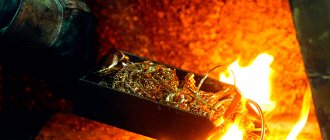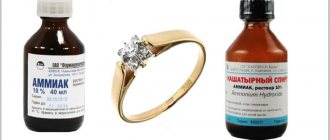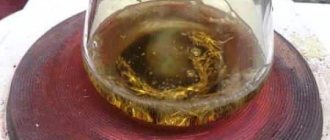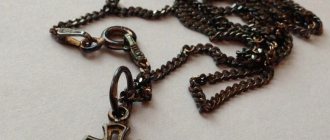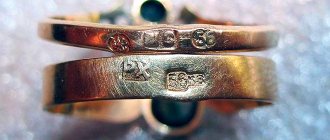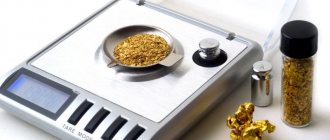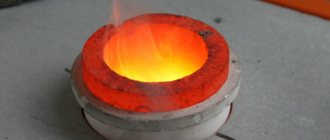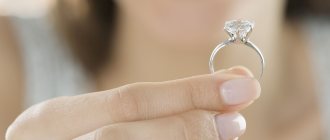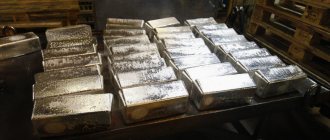Krayukhin S. A., Director of Science, National Private Educational Institution of Higher Education "Technical University of UMMC"
Krayukhin Sergey Aleksandrovich, Director of Science, National Private Educational Institution of Higher Education "Technical University of UMMC"
Currently, mining and processing plants have accumulated a huge amount of pyrite tailings from the processing of sulfide ores of non-ferrous metals. Their repeated processing for the purpose of extracting gold, copper and zinc is of main practical interest, taking into account the current level of development of engineering and technology. The search for an economically feasible technology for processing pyrite tailings has been carried out by many scientific institutes and organizations for a long time. Previously, UMMC worked on various options for possible processing, but they were economically ineffective (given the existing market conditions at that time) due to high costs and involved the use of very toxic reagents and an expensive stage of neutralization of secondary tailings after leaching.
To select the most preferable option for processing pyrite tailings, a laboratory for the integrated use of raw materials and advanced developments was created at the UMMC Technical University, an analysis of the chemical composition of stale pyrite tailings from UMMC enterprises was performed, and the applicability of the results of previously performed research was assessed.
Two different approaches were taken to the experimental verification:
1) development of a complex technology, including the extraction (lifting) of stale tailings, “deep” oxidative processing to open the ore component and the extraction of all valuable metals to obtain liquid marketable products from them with high added value: copper and zinc in cathodes, iron sulfate, gold-silver alloy - Dore alloy;
2) development of technology for selective extraction of metals: sequential two-stage underground leaching of non-ferrous and precious metals from pyrite tailings directly at their location with separate separation of metals from productive solutions in the form of middling products suitable for inclusion in traditional metal production schemes.
According to the first option, the increased costs of the technology should hypothetically be compensated by the high extraction of metals and the high cost of commercial products based on them. In the second option, the main task is to determine the economically feasible extraction of metals at minimal costs. Both approaches were tested at the UMMC Technical University in relation to real objects - technological samples of tailings from the company's enterprises.
Aqua regia: history of the name, proportion of acids and chemical properties
The properties of Aqua Regia were described even before hydrochloric acid was discovered in the 14th century. The composition became widespread and got its name during the heyday of alchemy on the European continent. The German alchemist Albertus Magnus (of Cologne), who was the mentor of Thomas Aquinas, called it aqua secunda as a derivative of aqua prima, nitric acid.
Translated from Latin: “secondary vodka” and “primary vodka”.
Aqua regia is a very strong acid.
Representatives of the alchemical cohort began to call it royal when Cardinal Bonaventure, classified by Catholicism as the fathers of the church, established that a substance that combined two acids was capable of dissolving the “king of metals.” Previously, it was believed that the noble metal could not be changed by anything. The interaction of aqua regia and gold proved the opposite. In Russia, M.V. Lomonosov called the solution “royal vodka.”
The symbol of Aqua Regia, adopted by alchemists: ▽R. an inverted triangle is a sign of water.
Chemical products, when combined, interact and form a product composition that is highly active. This manifests itself in a strong odor with hints of chlorine and nitrogen dioxide. Nitrogen dioxide gas is yellow in color and resembles smoke of this tone.
At first, aqua regia has no color, but gradually acquires a yellow-orange hue, becoming a very strong oxidizing agent. If it is stored for some time, it gradually decomposes, releasing gaseous substances.
The rate of etching, that is, oxidation, or solubility level, of gold is about 10 µm/min. Other noble metals require heating to certain temperatures for the reaction to occur. This applies to rhodium and iridium. A metal such as silver has other properties. Dissolution in Aqua Regia does not occur; a layer of AgCl, a precious metal chloride, forms on the surface.
Preparation of the solution and cleaning instructions
Below is written in detail how to clean gold in a soda solution:
Soaking gold jewelry with a solution in a container with foil.
For this method you will need a piece of food foil and a strong solution of sodium salt in hot water.
| Sodium salt | 2 tablespoons |
| Water | 250 ml |
| Foil | 1 piece 30x30 centimeters |
| Salt* | 1 tablespoon |
*You should use salt carefully, and it is better to add less salt the first time than to spoil the jewelry.
- the bottom of the glass container is lined with foil;
- products are laid out on foil;
- soda and a little salt dissolve in a glass of hot boiled water;
- the resulting solution is poured into the container with the decoration;
- After 9-10 hours, the gold needs to be taken out, washed and dried.
Boiling gold jewelry in a soda solution.
| Water | 250 ml |
| Sodium salt | 1.5-2 tablespoons |
- Place a soft cloth on the bottom of a metal container and place the decoration on it;
- make a solution of water, detergent and soda;
- pour the solution over the product and place on low heat, boil for 20-25 minutes;
- After boiling, remove, rinse in clean water and dry.
Boiling in a solution of soda and detergent.
| Water | 250 ml |
| Sodium salt | 1.5-2 tablespoons |
| Detergent | 0.5 teaspoon |
- Place a soft cloth at the bottom of a metal container and place gold on it;
- make a solution of water, detergent and soda;
- pour the solution and put on low heat, boil for 20-25 minutes;
- After boiling, remove, rinse in clean water and dry.
Using a solution of baking soda with zinc.
| Water | 250 ml |
| Zinc | 1.5-2 grams |
| Soda Ash | 1-1.5 tablespoons |
- place a piece of zinc along with the product in a glass container;
- fill the container with a solution of soda ash;
- soak the jewelry in the solution for 5-10 minutes;
- remove, rinse and dry.
Attention! Gold (especially if it is not of very high quality) may not be cleanable using the household methods described above. In this case, the owner needs to experiment with the duration of soaking and boiling, the proportions of the solution and additives.
If this does not help, then stronger chemicals will have to be used. There is always a risk of severe damage to the jewelry, so if you are not confident in your abilities, it is better to turn to professionals.
What is the composition of aqua regia for dissolving gold and what reaction is possible at home
The exact weighted composition of the two acids is described as 65-68% by weight HNO3 and 32-36% HCl. The equation for the reaction that occurs when etching gold metal in a double acid solution:
Au + HNO3 + 4 HCl = HAuCl4 + NO + 2 H2O
Result: hydrogen tetrachloraurate (hydrochlorauric acid), nitric oxide, water.
From the composition of hydrogen tetrachloraurate, it is clear that the compound occurs between gold and hydrochloric acid. Nitric acid is present in the process as a catalyst with oxidizing properties.
Gold mining
The whole process takes place in three stages:
- Dissolving gold in aqua regia.
- Filtering the resulting solution.
- The process of gold precipitation after evaporation.
Safety rules when working with chemicals
A home chemical laboratory for refining processes similar to alchemical procedures requires maximum care and concentration.
Purification of gold using such complex reagents as highly active acids places serious demands on compliance with safety rules. The process lasts several hours, and the poisonous gases NOCl, Cl2, NO, NO2 evaporate along the way. This means that everything should take place either outdoors or in a room that is well ventilated, or has a powerful exhaust ventilation system.
It is necessary to protect your eyes with special goggles, your face with a respirator, and your body with appropriate protective clothing. No reagent should come into contact with body parts or face.
Mining gold from various parts , chips, SIM cards
The importance of meeting deadlines and proportions
In order for the reaction to be successful, the correct proportions must be maintained: 65-68% HNO3 to 32-35% HCl.
To obtain 1 g of gold, you will need about 5 g of reagent or 3.75 milliliters of hydrochloric acid. This proportion follows from the chemical formula for producing hydrogen tetrachloroaurate. When working with scrap precious metal to maintain proportions, before lowering it into an acid solution, you should run a magnet over it, which will remove particles of metals with ferromagnetic properties.
Further processing of raw materials takes place using chemical methods.
Pre-purification of gold in nitric acid
One of the methods for cleaning gold scrap or products containing precious metal is cleaning with nitric acid. It removes almost all accumulated impurities.
After this, the gold is dissolved using hydrochloric acid.
Chemical method of gold
The procedure for dissolving metal in acids and their gradual evaporation
The etching reaction mechanism is triggered by heating the mixture solution and adding nitric acid, which catalyzes the process. When all the metal has dissolved, it is no longer added, but proceeds to settling - the composition of this type is kept for about half an hour. Following this comes the filtration stage. For these purposes, filter paper of various qualities is useful. Iron sulfide – FeS – is often added to the filter.
Method for extracting gold from pyrite concentrate
The invention relates to a technology for extracting gold from pyrite concentrate. A method for extracting gold from a pyrite concentrate involves grinding the concentrate and pulse shock loading it to separate gold from the concentrate particles. In this case, grinding and impact loading are combined by moving concentrate particles with a particle size of 0.5-2.0 mm at a speed of 80-100 m/s with subsequent impact of the particles on an obstacle. Moreover, the obstacle plane is located at a distance of 0.4-0.6 m from the accelerating device perpendicular to the direction of particle movement. The technical result is to increase the extraction of gold from pyrite concentrate. 5 tab., 5 pr.
The claimed solution relates to technological processes for processing ore concentrates to increase the content of precious metals, in particular, to the release of gold microparticles from pyrite concentrate.
From the level of technological development it is known [RF Patent No. 2061074 C1, MKP6 C22V 11/08, 05/27/1996. Method of extracting gold from gold-containing ore concentrates] method of extracting gold from pyrite concentrate, including grinding the concentrate and shock-pulse loading it to separate gold from the concentrate. The disadvantage of this method is the low degree of gold recovery.
The closest to the claimed object is the solution [RF Patent No. 2310510 C2, IPC V02S 19/06, 11/20/2007], in which the grinding of the concentrate and its shock-pulse loading for separating gold from the concentrate are combined due to the acceleration and impact of concentrate particles on an obstacle in the form of a grinding plate. This increases the efficiency of concentrate grinding and increases the rate of gold recovery from the concentrate by producing fine gold particles. But the degree of gold extraction in this solution is insufficient; small gold particles remain undisclosed and, accordingly, not extracted from the crushed concentrate particles. This is due to a number of limitations, for example, the low speed of particle collisions with the grinding plates.
The technical result of the proposed solution is to increase the degree of gold recovery. This is achieved by disclosing much smaller gold particles in the concentrate. This is done by regulating the size (size) of the concentrate particles, which are given movement at the required speed to hit an obstacle, made in the form of a plane perpendicular to the direction of movement of the particles and spaced from the accelerating device at a certain distance.
Thus, the claimed object, like the prototype, includes grinding the concentrate and its pulsed shock loading to separate gold from the concentrate particles. However, the claimed object differs in that it combines grinding and impact loading by moving concentrate particles with a particle size of 0.5-2.0 mm at a speed of 80-100 m/s, followed by the impact of the particles on an obstacle, the plane of which is located at a distance of 0.4- 0.6 m from the accelerating device perpendicular to the direction of particle movement. The specified numerical values of the parameters are related to the following:
— the technical result is achieved by the fact that the opening is carried out by striking the concentrate particles against an obstacle with the energy necessary for the finely dispersed destruction of the main fraction of pyrite and separation of gold from it;
— this separation of gold from concentrate is essentially a process of its enrichment and makes it possible to increase the degree of gold extraction several times in comparison with the prototype and reduce it.
These differences are new and meet the requirements of essential features and patentability of the solution.
The method was carried out as follows.
We used gold-bearing pyrite concentrate with a gold content of up to 320 g/t. The concentrate was pre-crushed and then the inventive method was carried out. The results were assessed by the degree of gold recovery from the concentrate. The regulatory criterion for gold recovery was understood to be the following: if using electron microscopy and electrodisperse X-ray microanalysis, gold particles less than 5 microns in size are detected in the concentrate waste, then the degree of gold recovery is sufficient; if larger gold particles are detected, then the degree of gold recovery is insufficient and additional optimization of the parameters is necessary , affecting the efficiency of pyrite grinding and, accordingly, the separation of gold particles from it. To implement the method, impact-throwing devices (shot blasting machines, shot blasting machines, sandblasting machines) were used. General ideas about the energy of the shock pulse of solids were used as parameters that optimize the degree of gold recovery. In particular, they varied the kinetic energy of a moving body (the size of the concentrate particles, the speed of their acceleration), the energy of damping the force impulse when particles hit an obstacle (the distance of the obstacle from the accelerating device, the shape of the obstacle and the angle of inclination of the obstacle surface to the direction of particle motion). As a result, it was stated that:
— gold particles ranging in size from 0.2 microns to 100 microns or more are found in the initial concentrate;
— after processing the initial concentrate according to the claimed method, gold particles with a size of 5 microns or more are extracted (separated from the concentrate);
- after processing the initial concentrate by the indicated known methods, gold particles of such small sizes are not separated from the concentrate and go to waste along with it.
The conclusion follows from this: the claimed method allows the discovery of much smaller gold particles in the concentrate, which, accordingly, increases the degree of gold extraction.
The following are examples of the implementation of the proposed method with optimization of its parameters. Before this, for comparison at a given concentration of gold in the concentrate, separate information is provided on the degree of gold recovery when implementing the analogue method and the prototype method.
An example of the implementation of an analogue method [RF Patent No. 2061074 C1, MKP6 C22V 11/08, 05/27/1996]. According to this method, portions of gold ore conglomerates were introduced into a centrifugal impact crusher. At the exit from the crusher, commercial ore with different particle sizes was obtained. An electron fractographic study of particles established that the best conditions for opening the ore for gold extraction were provided (gold particles larger than 50 microns in size were opened) in particles with a particle size of no more than 2-3 mm. Larger particles were screened out and reloaded into the crusher. Processing a portion of conglomerates took considerable time (average labor intensity was 200 kg/min). The degree of gold recovery was limited by the fact that gold particles larger than 50 microns in size were exposed on crushed ore particles. The smaller gold particles remained locked in the cracks and pores of the ore particles. Increasing (until the linear speed of 150 m/s on the crusher beater) the rotation speed of the crusher rotor (increasing the energy impulse of the blower hitting an ore particle) did not lead to greater crushing of the ore, did not increase the degree of gold extraction, but only increased energy consumption due to idle movement crushed mixture of ore particles in the crusher body and made it difficult for the mixture to exit the crusher.
An example of the implementation of a prototype method [RF Patent No. 2310510 C2, IPC V02S 19/06, 20.11.2007]. According to this method, ore particles (similar to those described above) were processed (enriched) by combining grinding and shock-pulse loading in a grinding machine by hitting the grinding plates. It has been established that, depending on the conditions of implementation of the method (particle size, degree of wear of the grinding plates, etc.), the maximum degree of gold extraction is achieved with maximum particle grinding. The best result was the following: gold grains larger than 25-30 microns in size were separated from the rock (opened).
Examples of implementation and optimization of the proposed method. Particles of gold ore were placed in a percussion-throwing apparatus and ensured linear movement in a given direction. On the way of movement, the particles hit an obstacle. The ore particles upon impact were destroyed predominantly along the pyrite-gold boundaries. In this case, the gold particles turned out to be open or completely separated from the pyrite. The separation of gold from pyrite occurs under the influence of an inertial force impulse at the moment an ore particle hits an obstacle due to the fact that the density of gold (19.32 g/cm3) is significantly higher than the density of pyrite (4.9-5.2 g/cm3), and their elasticity coefficients are significantly different.
The particle size of gold ore, their speed of movement and the location of the obstacle were varied within certain limits to optimize the enrichment process. Some information is given in Table 1 for the case of an obstacle in the form of a rectilinear plane, spaced from the accelerating device (impeller) at a distance of 0.55 meters with an inclination of 10 degrees to the direction of particle movement. Table 1 data shows:
— the degree (how many times smaller gold particles are extracted) of gold extraction using the claimed method is higher than using the prototype method in the specified range of parameters;
— there is no clear pattern of influence of the size of ore particles and the speed of their movement on the degree of gold extraction, but the range in which it is possible to extract the smallest gold particles is noticeable.
Due to these circumstances, there was a need to optimize the parameters of the implementation of the proposed method.
Example 1. Determination of the rational size (fineness) of ore particles.
The proposed method is based on the following physical phenomena:
— the particle size of gold-containing concentrate is proportional to its mass;
— mass proportionally affects the amount of kinetic energy with which the particle moves and hits an obstacle;
— the higher the kinetic energy, the greater the internal stresses that arise at the moment of impact with an obstacle at the interface between gold and pyrite;
— the greater the internal stresses, the greater the probability of separation of gold from pyrite and, accordingly, the greater the possibility of opening of pyrite particles with gold;
— the more gold separated from pyrite, the higher the degree of gold recovery (concentrate enrichment);
- the more gold is separated from pyrite, the smaller the size of the gold particles that are separated.
The results of testing the proposed method with particles of different sizes are partly shown in Table 1, but the results of optimizing the size (establishing range boundaries) of particles are given taking into account the particle acceleration rate in Table 2.
As a result of implementing the method, for these conditions it was established:
— the highest degree of gold recovery was achieved over the entire speed range with a pyrite particle size of 1.2-1.7 mm;
— with smaller and larger particle sizes, the degree of gold extraction decreased (but it is still higher than that of the prototype method);
— in the size range from 0.5 mm to 2.0 mm, separation of gold particles measuring 0.5 microns (or more) from the concentrate is clearly observed, i.e. this is the range with the highest gold recovery;
| Table 1. | ||||||||||||||||
| Comparative assessment of the degree of gold recovery using the proposed method in comparison with the prototype method. | ||||||||||||||||
| Comparable parameters | According to the prototype method | According to the claimed method | ||||||||||||||
| Ore particle size, mm | ||||||||||||||||
| 3,0 | 2,0 | 1,0 | 0,5 | 0,3 | ||||||||||||
| Particle movement speed, m/s | ||||||||||||||||
| 70 | 100 | 150 | 50 | 100 | 150 | 50 | 100 | 150 | 50 | 100 | 150 | 50 | 100 | 150 | ||
| Size of revealed minimum gold particles, microns | 30 | 23 | 12 | 24 | 26 | 5 | 11 | 12 | 5 | 8 | 12 | 10 | 18 | 28 | 14 | 20 |
| Relative conditional degree of gold recovery (ore beneficiation) | 1.0 (taken as one) | 1,3 | 2,5 | 1,2 | 1,1 | 6,0 | 2,7 | 2,5 | 6,0 | 3,7 | 2,5 | 3,0 | 1,6 | 1,1 | 2,14 | 1,5 |
| Note: | ||||||||||||||||
| 1. Here and below, information is provided on the enrichment of ore and waste obtained at the mining and processing plant. | ||||||||||||||||
| 2. For commercial reasons, here and below the direct level of gold presence in ore or waste, the degree (level) of enrichment, etc. is not indicated. To characterize the compared methods, relative indicators are given, for example, the relative conditional degree of ore enrichment (how many times smaller gold particles were obtained separated from the ore in comparison with the prototype method), the relative level of ore enrichment (what place does this value of enrichment occupy in the series of decreasing places during the experiment), etc. |
| Table 2. | ||||||||
| Relative degree of gold recovery (place in a series of values*) when changing the size of ore particles | ||||||||
| Speed of movement of concentrate particles, m/s | Size characterizing the particle size of the concentrate, mm | |||||||
| 0,3 | 0,5 | 0,8 | 1,2 | 1,3 | 1,7 | 2,0 | 2.2 | |
| 75 | 7 | 4 | 3 | 1* | 2 | 3 | 5 | 6 |
| 100 | 7 | 5 | 3 | 1 | 1 | 2 | 4 | 6 |
| 125 | 8 | 5 | 4 | 1 | 2 | 3 | 6 | 7 |
| * Numbers indicate places in a series of values. For example, at a speed of 75 m/s, the first (best) place (best gold recovery) was obtained with a particle size of 1.2 mm. Third place (two thirds of the enrichment results) was achieved with a particle size of 0.8 mm and 1.3 mm. At a movement speed of 100 m/s, the best identical results were recorded for dimensions 1.2 mm and 1.3 mm. |
- outside the range of 0.5-2.0 mm, not all gold particles with a size of 0.5 microns turned out to be separated from the concentrate (at least there are gold particles that were partially opened, i.e. exposed, but not separated).
Example 2. Determination of the rational speed of movement (acceleration) of concentrate particles.
Data from tables 1 and 2 indicate that the particle velocity affects the degree of gold recovery. In example 1, the rational particle size of a moving conglomerate was identified; now it is necessary to determine the rational speed of movement for this particle size. Experimental data are shown in Table 3.
| Table 3. | ||||||||
| Relative degree of gold recovery (place in a series of values*) when changing the speed of movement of concentrate particles | ||||||||
| Size, mm, characterizing the particle size of the concentrate | Speed of movement of concentrate particles, m/s | |||||||
| 50 | 70 | 80 | 90 | 100 | 110 | 130 | 150 | |
| 0,5 | 7 | 4 | 3 | 1 | 2 | 3 | 5 | 6 |
| 1,25 | 6 | 3 | 1 | 1 | 1 | 2 | 4 | 5 |
| 2,0 | 8 | 4 | 3 | 1 | 2 | 5 | 6 | 7 |
| * Numbers indicate places in a series of values. For example, with a particle size of 1.25 mm, the first (best) place was obtained at three different speeds of 80 m/s, 90 m/s and 100 m/s. The next (lower second) place was obtained at a speed of 110 m/s. |
From the data in Table 3 it follows that the maximum degree of gold recovery under these conditions is achieved for a rational particle size (0.5-2.0 mm) at conglomerate movement speeds of 80-100 m/s.
Example 3. Determination of the rational distance of the obstacle from the accelerating device.
The distance between the obstacle and the point where the conglomerate particles leave the accelerator device regulates the kinetic energy acquired by the particle during flight. With this energy, the particle collides with an obstacle and is destroyed (crushed with the separation of gold particles). The greater the distance, the more the particle velocity is damped, and the less force the collision occurs. But it is not possible to reduce this distance to a certain absolute value due to the fact that particles reflected from an obstacle collide with flying particles and deflect them from the required flight path, thereby reducing the degree of gold recovery. Accordingly, it became necessary to select this distance such that, at the selected particle size and speed, the interference from reflected particles would be minimal, and the degree of gold recovery would be sufficient. Due to a number of circumstances, the selection of this distance was carried out for an obstacle that had a flat shape, and the plane was located perpendicular to the direction of motion of the particles. The experimental data are shown in Table 4 (particle size 1.2 mm, particle speed 90 m/s).
| Table 4. | |||||||
| Relative degree of gold recovery (place in a series of values*) when changing the location of the obstacle plane | |||||||
| Obstacle distance from accelerating device, m | 0,1 | 0,2 | 0,3 | 0,4 | 0,5 | 0,6 | 0,7 |
| Relative recovery | 5 | 2 | 1 | 1 | 1 | 3 | 4 |
| * Note: the maximum degree (first place in a series of experiments performed) was achieved at a distance of (0.3-0.5) meters. |
From the table data it follows that the optimal distance is 0.3 m - 0.5 m.
Example 5. Determination of the rational angle of inclination of the obstacle plane.
Changing the angle of inclination of the obstacle plane relative to the direction of movement of the concentrate particles is possible in the horizontal and vertical planes. This will affect the efficiency of separation of particles after their collision with an obstacle, the level of interference of reflected particles to particles moving towards the obstacle, the force of collision of particles with an obstacle, and, consequently, the degree of gold recovery.
In the above examples, the obstacle was a rigidly fixed massive (mass exceeding 1000 or more times the mass of the concentrate particles) object with a plane-parallel surface for impacting the moving concentrate particles. The hardness and strength of the obstacle material exceeded the same characteristics of the concentrate. The dimensions of the surface were not of fundamental importance due to the fact that the dispersion angle of the particle flight trajectories was insignificant. It was assumed that in a perpendicular position, the kinetic energy of particle movement is to a greater extent realized in the process of destruction of pyrite and separation of gold. However, experiments were carried out to change the angle of inclination of the obstacle plane in the vertical plane when counting the angle of inclination from the vertical counterclockwise. The results are shown in Table 5.
| Table 5. | |||
| Relative degree of gold recovery (place in a series of values*) when changing the deviation of the angle of inclination of the obstacle plane from the perpendicular position | |||
| Deviation value, degree | 0 | 5 | 10 |
| Extraction rate | 1 | 2 | 3 |
| *Note. The first place means that the best degree of extraction was achieved with a deviation of 0 degrees (with an adjustment accuracy of plus or minus 1 degree), i.e. when the plane is positioned perpendicular to the direction of particle motion. |
From the data in Table 5 it follows that the most optimal location is perpendicular to the obstacle plane relative to the direction of the speed of movement of the concentrate particles.
The given examples prove the achievement of a technical result.
A method for extracting gold from pyrite concentrate, including grinding the concentrate and its pulsed impact loading to separate gold from concentrate particles, characterized in that grinding and impact loading are combined by moving concentrate particles with a particle size of 0.5-2.0 mm at a speed of 80-100 m/s with subsequent impact of particles on an obstacle, the plane of which is located at a distance of 0.4-0.6 m from the accelerating device perpendicular to the direction of particle movement.
Section question - answer
How to make aqua regia to dissolve gold?
Expert opinion
Pribrezhny Gennady Valentinovich
Jeweler 6th category
The composition in which two acids act is obtained by combining them in a certain percentage ratio: 65-67% HNO3 and 33-35% HCl. When converted to pure substances, one to two.
How to precipitate gold from aqua regia at home?
Expert opinion
Grishanov Mikhail Petrovich
Jeweler, director of the Grishanov and Co. workshop
If you carry out the etching reaction at home, several chemical reagents are applicable and relatively safe:
- inkstone; FeSO4 is added with an aqueous solution, proportion 1 to 2;
- oxalic acid can be successfully used in secondary precipitation;
- sodium pyrosulfite is suitable for secondary precipitation, added in pure form, in an aqueous solution, requires caution: if something is done wrong, harmful gaseous substances will be released;
- Hydrogen peroxide must have a high concentration for the process to proceed.
- Hydrazine is a strong solvent, not very suitable for home use; if used, it must be added in small drops, since if not done carefully, an explosion may occur.
Mined gold after deposition
Cleaning medical gold
Medical gold is an alloy of brass, silver, copper, titanium and zinc, but there may be no gold in it at all: the alloy already has a noble “golden” luster. Products made from medical gold are durable, not subject to external mechanical influences, and due to the special technology of polishing and sputtering, they practically do not darken, do not lose shine, and do not change color.
- If it is necessary to clean such jewelry from contamination, the following methods are used:
- Rinse in a solution (2 drops of shampoo or liquid soap per 0.5 cup of water) and clean the product with a soft brush.
- To remove dust, wipe the product with a cotton swab soaked in beer; there is no need to rinse with water after this.
- Wipe the decoration with table vinegar, and then be sure to rinse in running water.
Exposure to moisture and temperature
Before mechanical cleaning, you should learn more about the stone that is inserted into the gold jewelry. If there is no information on the Internet on how to clean a mineral, you can seek advice from a jeweler.
Some stones are contraindicated for prolonged contact with water and temperature changes. Boiling water can damage the adhesive and the insert will fall off. The best solution would be to take such jewelry to a workshop for cleaning. If this is not possible, then the stone needs to be isolated from water: held above the surface, wrapped or sealed with something.
Pearls, opal, amber and turquoise do not tolerate moisture. Contact with hot water and sudden changes in temperature can lead to discoloration, tarnishing and even destruction of the structure of the stone.
The effect of soda solution on precious and semi-precious stones
You need to be extra careful when cleaning gold jewelry with stones. In the case of precious stones, polishing using baking soda is allowed, since the stones are much harder and less susceptible to mechanical stress.
It must be remembered that the substance can damage the structure of the insert. It is recommended to pay special attention to porous, opaque minerals.
Such damaged stone may begin to deteriorate over time and develop defects that cannot be corrected. In any case, prolonged contact of the chemical solution and the jewelry stone should be avoided.
